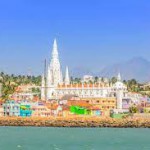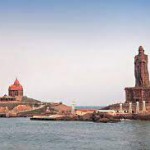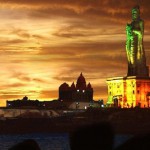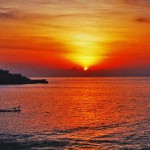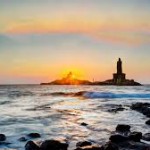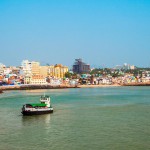| Kanyakumari City |
| About: |
| Kanyakumari is the southernmost point of peninsular India and the confluence of three oceans, the Bay of Bengal, the Arabian Ocean and the Indian Ocean. It is well known as the main Hindu pilgrims center of India. It is said that views of sunrise and sunset over the water is mind blowing and very rare of its kind in the world. Beaches of Kanyakumari look like rainbow, because sand is multicolored here. Once referred as the Alexandria of the East, Kanyakumari has been great center of art, culture, civilization and pilgrimage for numerous years. Kanyakumari was once referred to as the Alexandria of the east. This place has been a grevivekanand-rockat center for art, culture, civilization, and pilgrimage for years. It was also a famous center for commerce and trade. During the early part of the eighth century AD Islam entered the southern part of India through the sea route with traders and missionaries. Through St. Thomas, one of the twelve Apostles of Christ, Christianity arrived in this area in AD 52. Islam, Christianity and Jainism have greatly contributed to the architectural wealth and literary heritage of this place. Kanyakumari was also under the control of the Cholas, the Cheras, the Pandyas and the Nayaks who were great rulers of south India. The architectural beauty of the temples is the work of these rulers.The city at the southernmost tip of India, Kanyakumari offers you the mingling of three great seas, namely the Bay of Bengal, the Arabian Sea and the Indian Ocean and the great beaches from where you can see these giant water bodies. Also known as Cape Comorin, it is the district headquarters and an important pilgrimage place of the region. The sunrise and sunset here is exceptionally beautiful, especially on full moon days when one can see the setting of sun and rising of moon almost simultaneously. Endowed richly with paddy fields and coconut groves, the place is named after the Goddess Kannyakumari Amman, the presiding deity of the area. It is said that Devi Kanya, one of the incarnations of Goddess Parvati did penance on one of the rocks here to woo Lord Shiva.Surrounded by Majestic Hills and the plains bordered by colourful sea-shores, fringed with coconut trees and paddy fields, here and there are few elevated patches of red cliffs with undulating valleys and plains between the mountainous terrain and the sea – coast, so closely interwoven with Temples and Churches and other edifices lies the district, ‘Kanyakumari’. |
| The multi-colored mineral sand of Kanyakumari is indeed a unique trait. The city was once known as the ‘Granary of Travancore’ because of high-yielding paddy fields. The rocky and dangerous seashores are kept out of limit for the tourists by a manmade wall and tourists are constantly warned to stay off the rocks. There is a lighthouse too from where you can get some of the most wonderful and exotic views of the surrounding scenery. The rough seas and furious sea waves are not suitable for sunbathing or swimming but one can look for a huge variety of shells on the Kanyakumari beach and visit the Vivekananda memorial that recently came into limelight when giant waves hit it during the Tsunami disaster. |
| Location info: |
| Kanyakumari City,Tamil Nadu,India |
| Climate/Weather: |
| Climate Being a coastal region, harboring at the confluence of the three oceans, Kanyakumari has a placid weather with little fluctuation to its weather temperaments. However the ideal time to visit is between October and March. With the tropic climate, Kanyakumari has April to June the hottest with temperature reaching out to maximum 350C. November to February is the coolest period with temperature hovering around 210C. Northeast Monsoon brings gentle sweep of rains between October and December. |
| History of KanyakumariCity: |
| Kannyakumari has been named after the Goddess Kannyakumari Amman who is the popular deity of the area. It merged with Tamil Nadu in 1956 under the State Linguistic Reorganization Act. It was once referred to as the Alexandra of the East. Kanyakumari was under the control of the Cholas, the Cheras, the Pandyas and the Nayaks who were great rulers of south India. These rulers also take credit for constructing marvelous temples here. The British named Kanyakumari as Cape Comorin, because they could not pronounce its name. During the Raj, it was also major center for trade and commercial port. |
| Educational Institutions KanyakumariCity: |
| Arts & Science:Annai Veilankanni College, Kanyakumari Arignar Anna College, Kanyakumari Holy Cross College, Nagercoil Lakshmipuram College of Arts and Science, Kanyakumari Malankara Catholic College, Kanyakumari Muslim Arts College, Tiruvithamcode, Kanyakumari Nesamony Memorial Christian College, Kanyakumari Noorl Islam Arts and Science College, Kanyakumari Pioneer Kumarasamy College, Nagercoil S.T. Hindu College, Nagercoil Scott Christian College, Kanyakumari Sivanthi Adithanar College, Nagercoil Sree Ayyappa College for Women, Kanyakumari Sree Devi Kumari Women’s College, Kanyakumari St. Jude’s College, Kanyakumari Udaya College of Arts and Science, Kanyakumari V.T.M College of Arts and Science, Kanyakumari Vivekananda College, Agasteeswaram, Kanyakumari Women’s Christian College, Nagercoil Hotel Management:Muslim Arts College, Tiruvithamcode, KanyakumariDental:Sree Mookambika Institute of Dental Sciences, KanyakumariEngineering:Anna University Tirunelveli, Nagercoil Campus, Nagercoil Annai Vailankanni College of Engineering, Azhagapapuram (PO) Arunachala College of Engineering for Women, Nagercoil Bethlahem Institute of Engineering, Karungal C.S.I. Institute of Technology, Kanyakumari D.M.I. Engineering College, Kanyakumari Immanuvel Arasar J.J. College of Engineering, Nattalam James College of Engineering and Technology, Kanyakumari Jeyamatha Engineering College, Aralvaimozhi K.N.S.K. College of Engineering, Kanyakumari Lord Jegannath College of Engineering and Technology, Kumarapuramthoppur Post Loyola Institute of Technology and Science, Thovalai Maria Collge of Engineering and Technology, Thiruvattar PO Marthandam College of Engineering and Technology, Veeyanoor Narayanaguru College of Engineering, Kanyakumari Noorul Islam University (Noorul Islam College of Engineering), Thuckalay Ponjesly College of Engineering, Agesteeswaram Sardar Raja College of Engineering, Tirunelveli Satyam College of Engineering & Technology, Aralvaimozhi St. Xavier Catholic College of Engineering, Chunkankadai Sun College of Engineering and Technology, Erachakulam Post Udaya School of Engineering, Kanyakumari Vins Christian College of Engineering, Kalkulam Taluk Vins Christian Women’s College of Engineering, NagercoilHomoeopathy:Saradha Krishna Homoeopathy Medical College, Kanyakumari White Memorial Homoeopathic Medical College, Kanyakumari |
| Langauge |
| Tamil, Malayalam (due to its proximity to Kerala) and English are widely spoken by the people. |
| Culture: |
| The culture is a mixture of Tamil Nadu and Kerala. Christianity, Hinduism and Islam are the main religions practiced, with Christians accounting to nearly half of the populace. Some of the communities in the district are Nadars, Nanjil Nadu Vellalars, Paravas, Mukthavas, Vilakki Thalanayar, Kammalar or Asari, Chackarevars, Kerala Mudalis etc.Fairs:The festivals of Dharmapuri are varied and add an extra spark of life to the town’s daily lives. Notable among.Festivals:Pongal :Like all the other regions of Tamil Nadu, Pongal is one of the most important festivals of Dharmapuri. Mahashivaratri :If you are planning a tour to Dharmapuri, one of the best times to visit would be during February when the festivities of Mahashivaratri promise to add a dash of special flavor to your vacation.Bow Song: This is locally known as Villu Pattu. It is an ancient form of musical – story – telling art of southern Tamil Nadu. This art is famous particularly in Southern Tamil Nadu.Bow or the age-old weapon of warriors paradoxically lends itself to be used as a primary musical instrument for the Villu Pattu artists. Some of the important instruments that are used in these performances can be mentioned as follows Udukku, Kudam, Thala-Kattai etc. Udukku is mentioned in the ancient Tamil literature and it is described as Thudi, which is a small drum with a slender middle portion that is held in the left hand and played by the fingers of the right hand.This may be seen in the pictures and statues of Lord Nataraja also. Sometimes the Villu Pattu team divides itself into two groups, each trying to prove opposite view points of a subject by conducting the programme by exchange of questions and answers. This is called Lavani Pattu. The songs used by the Villu-Pattu artists are mostly traditional folk songs. This art is transformed by generation after generation. In today`s world folk art is regarded as most ethnic one and this is perfectly transmitted by bow song.Kalial: This is a folk dance played by group of men or boys in the countryside. A group leader sings songs and keeps time with cymbals. The players stand in a circle with sticks in their hand and dance round a lighted lamp repeating the songs sung by the leader. In course of time they turn, twist, lean forward and backward, squat and move round singing to the tune. At the beginning the steps are elaborate and at times, they are also very quick. When invited to perform in a function, the players generally begin the dance with an invocation for heavenly aid and conclude the dance with a torch -dance using lighted torches. This folk dance exhibits the artistic and recreative life of the countryside a swell. This dance is very refreshing to perform as well as to enjoy.Kathakali Kathakali: This is a unique form of drama, which has its origin in Travancore. Kathakali or story-dance is a relatively recent development of earlier dances. This happened during fifteenth or sixteenth century. This dance form arose out of religious expression through symbolical action. In this art form, the characters express their ideas not by words, but by significant gestures. Like eye movement, lip movement, etc. The movements are adopted from the Bharatha Natya with suitable modifications. The Bhagavathar recites the conversations between the characters as well as the narrative portion of the story in a loud voice. This is always accompanied by musical instrument. All these conversations should invariably be in verse. The action is promoted by his words.The costume and make up of the actor are also important aspects in Kathakali. There are standard make up for the different types of actors. Mainly red, yellow, green, black and white are the colours used in this art form. The headdresses are made of lightweight wood and are decorated with pieces of mirror, spangles, and colored stones. Usually, a Kathakali performance extends from eight to ten hours. With the advent of the cinema, the popularity of this art has declined. It is now played in the temples at Thiruvattar, Thirparappu, Ponmana, Kuzhithurai, Neyyoor and Munchira in the Kanyakumari District twice a year during the time of festivals. But this art form is popular worldwide and people from different parts usually come to see the presentation.Karagam Dance: This is a kind of dance common in the countryside. Both men and women play it during the time of festivals and marriages. This is very popular and people perform it with full of joy and energy.Kalari: This is also known as Adimurai in Kanniyakumari district. This is an ancient martial art, which is still preserved in the villages of this district and also in Kerala. A tradition believed to have been founded by Paraurama is known Vadakkan Kalari. |
| How to reach KanyakumariCity? |
| Nearest Railway Station:Kanyakumari is well connected by train services to all the major cities of India up to Delhi and even further up to Jammu. |
| Nearest Airport:Trivandrum, 80 kms away, with regular flights to Bangalore, Mumbai, Cochin, Delhi, Goa, and Madras. |
| Road Transport:Kanyakumari is connected by regular bus services to and from all the major cities of South India including Chennai, Pondicherry, Bangalore, Trichy, Madurai, Rameshwaram, Nagercoil, Tuticorin, Tiruchendur, Tiruvelveli and Trivandrum. |
| Tourist Attraction of KanyakumariCity: |
| The Sangam: Beach in Tamil Nadu, South India Beaches Sangam is the meeting point of the three major bodies of water, the Bay of Bengal, the Arabian Sea and the Indian Ocean. It is a bathing ghat, with steps leading into the water and a sort of lagoon formed between land by a series of rocks. People bathe and jump around, getting lightly battered by the remains of waves, which are washing over the rocks.Kanyakumari Temple: The Kumari Amman Temple also known as Kanyakumari Temple is located on the shores and is dedicated to a Goddess the incarnation of Goddess Parvati, the virgin goddess who did penance to obtain Lord Shiva as her husband. The main attraction for tourists from around the world is the scintillating view of the temple and the adjoining ghats, which are sitting pretty on the shoreline. The diamond nose-ring on the statue of the deity adds an enchanting glow to the already shining statue. Famous for its sparkling gleam, it is said to be visible even from the mid of sea.Gandhi Mandapam: This is the place where the urn containing the ashes of Mahatma Gandhi was kept before a portion of which was immersed in the three seas. The exemplary temple is located near to the Kumari Amman Temple and is one of the most picturesque spots in Kanyakumari. The temple is build in such a way that on October 2nd, the birth date of Mahatma Gandhi, the rays of sun fall exactly on the spot where the urn containing the ashes is kept. So if possible choose this day to visit this splendid monument and witness the magical moment right in front of your eyes.Vivekananda Memorial Rock: Situated some 500m away from the mainland Vivekananda Memorial Rock attracts a large number of tourists and was built in the year 1970 in memory the great Swami Vivekananda. It is built on the same spot where Swami Vivekananda spent some of his time meditating. Keeping this in mind, the temple also has a meditation hall. So if you want to get rid of all the worldly tensions, take some time out and sit in the hall meditating all your problems away. From ancient times, even before the temple was built, the rock was considered a sacred place and was known as ‘Sripada Parai’ meaning that the rock is blessed by the touch of feet of ‘Devi Kumari’. Feel the spirituality of the place by sighting the divine footprints of the Goddess, which is visible on the rock.Padmanabhapuram Palace: Padmanabhapuram Palace: It’s a large mansion of the Travancore Kings, located around 40kms from Kanyakumari on the road to Thiruvananthapuram. Known for its natural splendor, the main attraction of the palace is its sheer aesthetic beauty, innovative designs and time tested wooden carvings. Known for its strategic planning and military architecture, the palace dates back to 17th or 18th century. Unlike north Indian palaces, it’s made of granite and teakwood displaying a perfect combination of clean lines and gentle angles, sloping tiled roofs of various interconnecting buildings. And the Palace has a dining hall, which seated 2000 Brahmins at one time! The palace is excellently maintained by the Archeological Survey of India, which offers a guided tour through the labyrinth of 108 rooms that is expressive of sheer opulence.Suchindram Temple: A small sleepy village Suchindram, located 12 kms from Kanyakumari, is profusely rich in art, culture and architectural heritage. The major spotlight of the place is the famous Sthanumalayan Temple, commonly known as Suchindram temple, which is notably marked for its artistic treasures. The temple is dedicated to a deity who is the representation of the combined forces of Siva, Vishnu and Brahma. It is one of the few temples in the country where the Trinities are worshipped. The temple has a beautiful 134ft tall gopuram, musical pillars and an excellent statue of the Hanuman, apart from valuable artifacts of different periods.Baywatch Water Amusement Park: Baywatch Water Amusement Park The interesting water park has many different types of rides available like the Bumping Car, Crazy Chairs, Giant Wheel, Milky Way, and Multiple Splash. It’s open every day of the year and it has many different attractions for adults and children including its world famous wax museum that is the counterpart of Wax Museum at London.Portuguese Church: Portuguese Church The church with its beautiful archaic structure is a major monument of Christian influence. The massive towering spires and stained glass window panes contribute to the overall grandeur of the Church. The simplicity of the interiors is a sharp contrast to the ornate Gothic exteriors. A walk down to the fishing jetty behind the church is quite interesting especially if the boats have just come in with their catch.Vattakottai Fort: Vattakottai Fort It is one of the many forts erected a symbol of military history of India. This small yet charming circular fort on the seashore, 6 kms away from Kanyakumari is an 18th century fort. So, only the ramparts and a few broken down structures of this granite fort have withstood the ravages of time. The isolated beach lined with coconut groves and dense vegetation overlooking the blue waters makes it an idyllic hideaway.Muttom Beach: The famous beach at Muttom is located about 16 kms from Nagercoil and 32 kms from Kanyakumari as well. Muttom is famous for its beautiful landscaping and high rocks dipping into the sea at the beachside. The sun set viewpoint at Muttom is very famous and one of the most Panoramic view points in the district. Another attraction of Muttom is the century old lighthouse built by the British. People come and see all these with full interest.Sanguthurai Beach: Sanguthurai is a beautiful beach resort and is very convenient for the local population of Nagarcoil. It is only about 10 kms from the city. Unfortunately no infrastructure facilities were available in this beach. The district administration has now sanctioned a project for putting up of a children`s park, seating facility, open huts or Kudils with Terracotta roofs and lighting facility at the beach. These facilities are expected to increase the tourism in the beach site. The entire work has been completed. It is also proposed to put up a few shops for Women Self Help Groups at the site. These will provide eatables for the tourists at the beach side. All these give a colourful impression to the tourists.Chothavilai Beach: This beach is located at the distance of about 10 Kms from Kanyakumari. This is one of the best natural beaches of the district. The beach has shallow water and High sand dunes on the background. The tourists can reach the beach through the newly laid coastal road, which is a very beautiful drive along the sea-coast. People enjoy the place very much as they visit this with of joy. |
| Hotels/Lodge/Accommodation in KanyakumariCity: |
| Tri Sea Hotel:Near Seashore,Kovalam Road, Kanyakumari, Tamil Nadu,India,Ph:04652 246586Sea View Hotel:E Car St,Nagercoil, Kanyakumari, Tamil Nadu,India,Ph:04652 247841Uday Samudra Beach Hotel:G V Raja Road Samudra Beach,Kovalam,Tamil Nadu,IndiaPh:0471 2485766 |
| Useful Links: |
| www.pearlsindiatour.com/kanyakumari.htmlwww.luxurytoursindia.allindiaguide.com/city…/kanyakumari–city-guide.html |
